แอลัน ทัวริง
จากวิกิพีเดีย สารานุกรมเสร
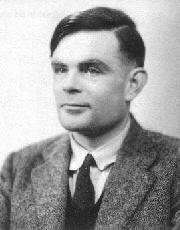 ี
ี
แอลัน ทัวริง (พ.ศ. 2455-2497) บิดาแห่งวงการคอมพิวเตอร์แอลัน แมททิสัน ทัวริง (Alan Mathison Turing) (23 มิถุนายน ค.ศ. 1912 (พ.ศ. 2455) - 7 มิถุนายน ค.ศ. 1954 (พ.ศ. 2497)) เป็นนักคณิตศาสตร์, นักตรรกศาสตร์, นักรหัสวิทยา และวีรบุรุษสงคราม ชาวอังกฤษ และเป็นที่ยอมรับว่าเป็นบิดาของวิทยาการคอมพิวเตอร์
เขาได้สร้างรูปแบบที่เป็นทางการทางคณิตศาสตร์ของการระบุอัลกอริทึมและการคำนวณ โดยใช้เครื่องจักรทัวริง ซึ่งตามข้อปัญหาเชิร์ช-ทัวริงได้กล่าวว่าเป็นรูปแบบของเครื่องจักรคำนวณเชิงกลที่ครอบคลุมทุกๆ รูปแบบที่เป็นไปได้ในทางปฏิบัติ
ในระหว่างสงครามโลกครั้งที่สอง ทัวริงมีส่วนสำคัญในการแกะรหัสลับของฝ่ายเยอรมัน โดยเขาเป็นหัวหน้าของกลุ่ม Hut 8 ที่ทำหน้าที่ในการแกะรหัสของเครื่องอีนิกมาที่ใช้ในฝ่ายทหารเรือ
หลังจากสงครามเขาได้ออกแบบเครื่องคอมพิวเตอร์อิเล็กทรอนิกส์ที่สามารถโปรแกรมได้เครื่องแรกๆ ของโลกที่ห้องปฏิบัติการฟิสิกส์แห่งชาติ และได้สร้างเครื่องคอมพิวเตอร์ขึ้นจริงๆ ที่มหาวิทยาลัยแมนเชสเตอร์ รางวัลทัวริงถูกก่อตั้งขึ้นเพื่อยกย่องเขาในเรื่องนี้
นอกจากนั้นแล้วการทดสอบของทัวริงที่เขาได้เสนอนั้นมีผลอย่างสูงต่อการศึกษาเรื่องสำนึกสังเคราะห์ ซึ่งในขณะมีถกเถียงที่สำคัญว่า: เป็นไปได้หรือไม่ที่จะกล่าวว่าเครื่องจักรนั้นมีสำนึกและสามารถคิดได้
[แก้] ประวัติ
แอลัน ทัวริง เป็นชาวอังกฤษ เกิดเมื่อปี พ.ศ. 2455 (ค.ศ. 1912) ที่ลอนดอน และอาศัยอยู่กับพี่ชาย. บิดาและมารดาของทัวริง พบกัน และทำงานที่ประเทศอินเดีย.
ในสมัยมัธยม ทัวริงสนิท และนับถือรุ่นพี่คนหนึ่ง ชื่อ คริสโตเฟอร์ มอร์คอม (Christopher Morcom) ซึ่งเสียชีวิตไปซะก่อน ทัวริงเศร้ามาก เลยตั้งใจสานต่อสิ่งที่รุ่นพี่เขาอยากทำให้สำเร็จ. ตลอดสามปีหลังจากนั้น เขาเขียนจดหมายอย่างสม่ำเสมอให้คุณแม่ของมอร์คอม ว่าเขาคิด และสงสัยเรื่องความคิดของคน ว่าไปจับจดอยู่ในเรื่องหนึ่ง ๆ ได้อย่างไร (how the human mind was embodied in matter) และ ปล่อยเรื่องนั้นๆ ออกไปได้อย่างไร (whether accordingly it could be realeased from matter) แล้ววันหนึ่งเขาก็ไปเจอหนังสือดังในยุคนั้นชื่อ "The Nature of the Physical World" อ่านไปก็เกิดนึกไปเองว่า ทฤษฏีกลศาสตร์ควอนตัม มันต้องเกี่ยวกับปัญหาเรื่อง mind and matter ที่เขาคิดอยู่
[แก้] การศึกษาและงาน
ปี พ.ศ. 2474 เขาเข้าเรียนคณิตศาสตร์ ที่ คิงส์คอลเลจ มหาวิทยาลัยเคมบริดจ์ (หมายเหตุ: ยุคนั้น คิงส์คอลเลจเป็นที่พักชายล้วน ซึ่ง ทัวริงก็อยู่อย่างเปิดเผยว่าเขาเป็นเกย์ และเข้าร่วมกิจกรรมชมรม) ทัวริงมีความสุขกับชีวิตที่นี่มาก และทำกิจกรรมหลายอย่าง เช่น พายเรือ, เรือใบเล็ก และ วิ่งแข่ง. ทัวริงพูดเสมอว่า "งานของผมนั้นเครียดมาก และทางเดียวที่ผมจะเอามันออกไปจากหัวได้ก็คือ วิ่งให้เต็มที่" และเขาก็วิ่งอย่างจริงจัง จนได้ระดับโลก โดยที่ผลการวิ่งมาราธอนของเขา ชนะเลิศการแข่งขันของสมาคมนักกรีฑาสมัครเล่น ด้วยเวลา 2 ชั่วโมง 43 นาที 3 วินาที ในปี พ.ศ. 2489. ซึ่งในการแข่งขันวิ่งมาราธอนโอลิมปิก เมื่อ พ.ศ. 2491 (ค.ศ. 1948) คนที่ได้เหรียญทอง ทำเวลาได้เร็วกว่าเขาเพียง 11 นาที
ส่วนในเรื่องวิชาการ ในวงการคณิตศาสตร์ยุคนั้น รัสเซิลล์ (Russell) เสนอเอาไว้ว่า "mathematical truth could be captured by any formalism" แต่ยุคนั้น โกเดล โต้ว่า "the incompleteness of mathematics: the existence of true statements about numbers which could not be proved by the formal application of set rules of deduction". พอปี พ.ศ. 2476 ทัวริงก็ได้เจอกับรัสเซิลล์ แล้วก็ตั้งคำถาม พร้อมถกเรื่องราวเหล่านี้ขึ้นมา ทำให้เขาสนใจ
ปี พ.ศ. 2477 ทัวริงก็จบจากมหาวิทยาลัยเคมบริดจ์ ด้วยเกียรตินิยมอันดับหนึ่ง. ทางมหาวิทยาลัย ก็เลยเชิญเขาอยู่เป็น Fellow ด้านคณิตศาสตร์ต่อ (ส่วนใหญ่ Fellow ของเคมบริดจ์จะเป็นพวกที่จบปริญญาเอก แต่ทัวริงจบเพียงปริญญาตรี) ปี พ.ศ. 2478 ทัวริงไปเรียนกับ จอห์น ฟอน นอยมันน์ เรื่อง ปัญหาของการตัดสินใจ (Entscheidungs problem) ที่ถามว่า "Could there exist, at least in principle, a definite method or process by which it could be decided whether any given mathematical assertion was provable?" ทัวริงก็เลยมาคิดๆ โดยวิเคราะห์ว่า คนเราทำอย่างไรเวลาทำงานที่เป็นกระบวนการที่มีกฏเกณฑ์ (methodical process) แล้วก็นึกต่อว่า ว่าวางกรอบว่าให้เป็นอะไรซักอย่างที่ สามารถทำได้อย่างเป็นกลไก (mechanically) ล่ะ? เขาก็เลยเสนอทฤษฏีออกมาเป็น "The analysis in terms of a theoretical machine able to perform certain precisely defined elementary operations on symbols on paper tape". โดยยกเรื่องที่เขาคิดมาตั้งแต่เด็กว่า 'สถานะความคิด' (state of mind) ของคน ในการทำกระบวนการทางความคิด มันเกี่ยวกับการเก็บ และเปลี่ยนสถานะจากจุดหนึ่งไปอีกจุดหนี่ง ได้ตามการกระทำทางความคิด, โดยทัวริงเรียกสิ่งนี้ว่า คำสั่งตรรกะ (logical instructions). แล้วก็บอกว่าการทำงานต้องมี กฎเกณฑ์ที่แน่นอน (definite method) (ซึ่งเป็นชื่อแบบดูเข้าใจง่ายเลยนะ แต่ยุคหลังถูกเปลี่ยนมาเรียกเป็นทางการว่า อัลกอริทึม)
พอปี พ.ศ. 2479 เขาก็เลยเตรียมออกบทความวิชาการที่มืชื่อเสียง "On Computable Numbers with an application to the Entscheidungsproblem" แต่ก่อนเขาออกบทความนี้ มีอีกงานของฝั่งอเมริกาของ Church ออกมาทำนองคล้ายๆ กันหัวข้อเหมือนๆ กันอย่างบังเอิญ เขาเลยถูกบังคับให้เขียนอิงงาน Church ไปด้วย (เพราะบทความเขาออกทีหลัง) แต่พอบทความเขาออกมาจริงๆ คนอ่านก็เห็นว่าเป็นคนละทฤษฏีกันและของเขามีเนื้อหา relied upon an assumption internal to mathematics แม่นกว่า การเน้นเรื่อง operation ใน physical world. (ยุคต่อมาคนก็เลยนำ concept เขาไปประยุกต์ใช้และอ้างชื่อให้เกียรติว่า Turing machine, the foundation of the modern theory of computation and computability -- ทำให้หลายๆ คนตั้งให้ แอลัน ทัวริง เป็น The Founder of Computer Science หรือ ผู้ริเริ่มศาสตร์คอมพิวเตอร์) ปลายปีนั้นเองเขาก็ได้รับรางวัล Smith's prize ไปครอง
แล้วเขาก็ไปทำปริญญาโท และปริญญาเอกต่อ ที่ศูนย์วิจัยของมหาวิทยาลัยปรินซ์ตัน ซึ่งสงบเงียบตัดห่างจากผู้คน แล้วก็ออกบทความว่า โลกทางความคิด กับ โลกทางกาย น่ะ มันเชื่อมถึงกันได้ ผ่านออกมาด้วยการกระทำ (ในยุคนั้นคนยังไม่คิดแบบนี้กัน) แล้วก็เสนอความคิดออกมาเป็น Universal Turing Machine (เครื่องจักรทัวริง) ในยุคนั้นยังไม่เรียกว่าคอมพิวเตอร์ แต่เรียกว่าเป็นเครื่องคำนวณที่สามารถป้อนข้อมูลได้ ต่อมาทัวริงก็สร้างเครื่องเข้ารหัส (cipher machine) โดยใช้รีเลย์แม่เหล็กไฟฟ้า สำหรับการคูณเลขฐานสอง หลังจากเขาสำเร็จการศึกษา มหาวิทยาลัยปรินซ์ตันก็เสนอตำแหน่งให้เขา แต่เขาตัดสินใจกลับเคมบริดจ์ เลยทิ้งทีมเพื่อนๆ ไว้และ จอหน์ วอน นอยแมน ก็เข้ามาสานต่อพอดี
ส่วนตัวทัวริง ก็เลือกไปทำงานด้าน 'ordinal logic' ต่อแทน เพราะเขาบอกว่าเป็น "my most difficult and deepest mathematical work, was an attempt to bring some kind of order to the realm of the uncomputable" เพราะ ทัวริงเชื่อว่าคนเรา โดยสัญชาติญาณสามารถตอบโต้ต่อเหตุการณ์ได้โดยไม่ต้องคำนวณ ("Human 'intuition' could correspond to uncomputable steps in an argument") แต่งานยังไม่เสร็จ ก็มีสงครามโลกซะก่อน คือก่อนหน้านั้นเขาก็ทำงาน (อย่างเป็นความลับ) ให้กับ British Cryptanalytic department (หรือเรียกกันว่า Government code & cypher school) พอสงครามเริ่มเขาเลยเปิดเผยตัวเอง (ปกติจะทำเป็น fellow ที่คิงส์คอลเลจ เคมบริดจ์ อยู่หน้าฉากงานเดียว) เลยออกย้ายไปทำงานที่ the wartime cryptanalytic headquaters, Bletchley Park เป้าหมายคือเจาะรหัสของเครื่องเข้ารหัสเอนิกมา (Enigma Cipher Machine) ของเยอรมันให้ได้
ช่วงนั้น ทัวริงทำงานกันกับ W.G. Welchman นักคณิตศาสตร์ชื่อดังของเคมบริดจ์อีกคน (คนนี้เจอ critical factors, ทัวริงทำ machanisation of subtle logical deduction) ทัวริงบอกว่าเขาเจาะรหัสได้แล้วคร่าวๆ ในปี ค.ศ. 1939 แต่ต้องได้เครื่องเอนิกมา มาวิเคราะห์การคำนวณทางสถิติเป็นขั้นสุดท้ายก่อน แล้วทุกอย่างจะออกหมด. แต่ต้องรอถึงปี ค.ศ. 1942 ที่เรือดำน้ำ U-boat ของสหรัฐไปยึดมาได้ และแล้วหลังจากนั้นเอนิกมาก็ไม่มีความหมายอีกต่อไป
พอสงครามเริ่มสงบปี ค.ศ. 1944 ทัวริงก็เริ่มสานต่อโครงการเก่าตั้งชื่อ "Buiding the Brain" แต่ตัดสินใจล้มโครงการไปในปี ค.ศ. 1945 พอได้ข่าวว่าที่ von Neumann ออกบทความเรื่อง EDVAC ออกมาจากฝั่งอเมริกา
ปี ค.ศ. 1946 ทัวริงกลับมาดูงานใหม่ ก็พบว่าเป็นงานคนละแนวคิดกัน ทางอเมริกาเน้นด้านอิเลกทรอนิกส์ แต่ทัวริงคิดแบบคณิตศาสตร์ ("I would like to implement arithmetical functions by programming rather than by building in electronic components, a concept different from that of the American-derived designs). โครงการตอนนั้นของทัวริง คือเครื่องคำนวณ (computation machine) ที่สามารถเปลี่ยนได้ตามใจชอบจาก numerical work เป็น algebra เป็น code breaking เป็น file handling หรือแม้กระทั่งเกมส์. ปี ค.ศ. 1947 ทัวริงเสนอว่า ต้องมีระบบจัดเก็บข้อมูล และ ชุดคำสั่งคอมพิวเตอร์ต้องขยายตัวเองออกเป็น ชุดคำสั่งย่อย ๆ ได้ โดยการใช้รูปย่อแบบ รหัสย่อ (คำสั่ง ซึ่งเป็นจุดเริ่มต้นของภาษาโปรแกรม) แต่ปรากฏว่าไม่ได้รับการสนันสนุน
มหาวิทยาลัยเคมบริดจ์ ยังคงเสนอตำแหน่งให้เขา แต่ทัวริงตัดสินใจเปลี่ยนสายขอพัก ไม่ทำด้านคณิตศาสตร์ ไม่ทำด้านเทคโนโลยี แต่ไปเล่นเรื่อง neurology กับ physiology sciences แทน แล้วก็ออกบทความเรื่องเครือข่ายประสาท ขึ้นมาว่า "a sufficiently complex mechanical system could exhibit learning ability" แล้วส่งบทความไปตีพิมพ์กับ NPL แต่ NPL ก็ทำงานช้า... อยู่ ๆ ทีมนักวิจัยที่เคมบริดจ์เอง (สมัยนั้นยังชื่อ Mathematical Laboratory อยู่ ยังไม่ได้เปลี่ยนเป็น Computer Laboratory) ก็ผลิตเครื่อง EDSAC ขึ้นมา (เป็นเครื่อง storage computer machine เครื่องแรก) โดยใช้หลักของ ชาร์ล แบบเบจ (Founder of Storage Machine) พร้อมๆ กับ มหาวิทยาลัยแมนเชสเตอร์ ได้ทีมของทัวริง ไปทำเครื่องในแนวทัวริงได้สำเร็จ
ทัวริงเลยขี้เกียจยุ่งเรื่องการแข่งขันผลงานทางวิทยาศาสตร์ (ช่วงนั้นผลิตกันเร็วมาก) เลยไปวิ่งแข่งแทน เพราะเวลาที่เขาวิ่งในปี ค.ศ. 1946 นั้น ทำให้เขามีสิทธิ์ลุ้นเหรียญทองวิ่งมาราธอนโอลิมปิก แต่โชคร้ายเขาประสบอุบัติเหตุรถยนต์ก่อน เลยไม่สามารถไปแข่งโอลิมปิกในปี ค.ศ. 1948 ได้ (ในปีนั้นคนที่ได้เหรียญเงินเวลารวมก็แพ้ทัวริง) สุดท้ายทัวริงก็เลยตัดสินใจกลับเคมบริดจ์ ผ่านไประยะนึง ทีมงานเก่าเขาที่ย้ายไปมหาวิทยาลัยแมนเชสเตอร์ ก็เชิญเขาไปเป็นหัวหน้าภาควิชาใหม่ (ภาควิชาคอมพิวเตอร์) ทัวริงเลยตัดสินใจย้ายไป คราวนี้ไปเน้นด้านซอฟต์แวร์ ออกบทความวิชาการชื่อดังอีกอันในยุคนั้น "Computer Machine and Intelligence" ในปี ค.ศ. 1950 ซึ่งเป็นรากฐานของแนวคิดพัฒนา ปัญญาประดิษฐ์ ในวงการคอมพิวเตอร์
ปี ค.ศ. 1951 เขาก็จับงานใหม่อีกเล่นอีกแนว morphogenetic theory ออกบทความเรื่อง "The Chemical Basis of Morphogenesis" ซึ่งต่อมาเป็น founding paper of modern non-linear dynamical theory (พวก pattern formation of instability into the realm of spherical objects, e.g. radiolaria, cylinder, model of plant stems)
แต่ปี ค.ศ. 1952 เขาถูกจับ โทษฐานมีเพศสัมพันธ์กับเด็กชาย ทัวริงไม่ปฏิเสธและยอมรับโทษแต่โดยดี มีทางเลือกให้เขาสองทางคือ หนึ่ง เข้าคุก หรือ สอง รับการฉีดฮอร์โมนเอสโตรเจนเป็นเวลาหนึ่งปีเพื่อลดความต้องการทางเพศ ซึ่งเขาเลือกที่จะรับการฉีดยา และแล้วปี ค.ศ. 1954 เขาถูกพบโดยพนักงานทำความสะอาด ในสภาพมีแอปเปิ้ลครึ่งลูกหล่นอยู่ข้างๆ และมีร่องรอยการทำการทดลองทางเคมีอยู่ใกล้ๆ
หลายปีต่อมา มีการเปิดเผยขึ้นมาว่า ตั้งแต่สงครามโลกสงบลง เขายังคงทำงานให้กับองค์การ 'รหัสลับ' แบบลับๆ ของรัฐบาลอยู่ อยู่ในสภาพที่ไม่สามารถบอกเพื่อนๆ ได้ว่าทำอะไรบ้าง และปิดบังมาตลอด ช่วงนั้นกำลังมีสงครามเย็น สหราชอาณาจักรกับสหรัฐอเมริกาเป็นพันธมิตรกัน สู้กับยุโรปตะวันออก, แต่เพื่อนชาวยุโรปตะวันออก ที่เคยร่วมงานกันมาก่อนพยายามติดต่อตัวเขา เช่นในปี ค.ศ. 1953 เพื่อนเขาชาวนอร์เวย์ (เป็นสังคมนิยม) ถึงกับมาเยี่ยม ขณะที่เขากำลังพักผ่อนอยู่ที่ประเทศกรีซ ทำให้พอเขากลับมาถึงอังกฤษ ก็ถูกเรียกไปคุยกับเจ้าหน้าที่ความมั่นคง แต่ก็ไม่มีใครรู้ว่าจริงๆ แล้วมันเกิดเรื่องอะไร? และมีเบื้องหลังอย่างไร
สำหรับผลงานที่เด่น ๆ ของทัวริง เช่น การคิดโมเดลที่สามารถทำงานได้เทียบเท่ากับคอมพิวเตอร์ (แต่อาจมีความเร็วต่ำกว่า) โดยใช้คำสั่งพื้นฐานง่ายๆ เพียง เดินหน้า ถอยหลัง เขียน ลบ เท่านั้นเอง
Alan Turing
From Wikipedia, the free encyclopedia
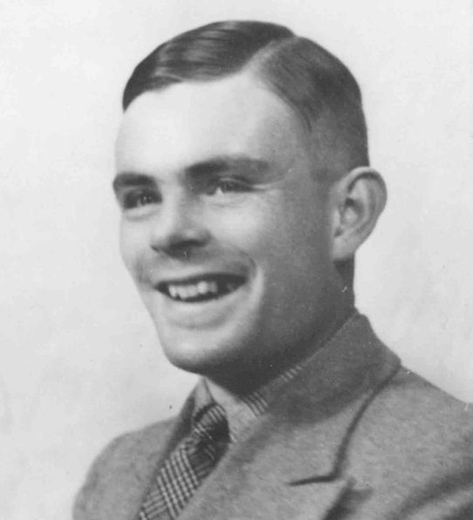
Alan Mathison Turing , OBE , FRS ( 23 June 1912 – 7 June 1954 ) was an English mathematician , logician , and cryptographer .
Turing is often considered to be the father of modern computer science . Turing provided an influential formalisation of the concept of the algorithm and computation with the Turing machine , formulating the now widely accepted "Turing" version of the Church – Turing thesis , namely that any practical computing model has either the equivalent or a subset of the capabilities of a Turing machine. With the Turing test , he made a significant and characteristically provocative contribution to the debate regarding artificial intelligence : whether it will ever be possible to say that a machine is conscious and can think . He later worked at the National Physical Laboratory , creating one of the first designs for a stored-program computer, although it was never actually built. In 1948 he moved to the University of Manchester to work on the Manchester Mark I , then emerging as one of the world's earliest true computers.
During the Second World War Turing worked at Bletchley Park , Britain's codebreaking centre, and was for a time head of Hut 8 , the section responsible for German naval cryptanalysis. He devised a number of techniques for breaking German ciphers, including the method of the bombe , an electromechanical machine that could find settings for the Enigma machine .
In 1952, Turing was convicted of "acts of gross indecency" after admitting to a sexual relationship with a man in Manchester. He was placed on probation and required to undergo hormone therapy . Turing died after eating an apple laced with cyanide in 1954. His death was ruled a suicide.
// if (window.showTocToggle) { var tocShowText = "show"; var tocHideText = "hide"; showTocToggle(); } //
[ edit ] Childhood and youth
Turing was conceived in 1911 in Chatrapur , Orissa , India . [1] His father, Julius Mathison Turing, was a member of the Indian Civil Service . Julius and wife Sara ( née Stoney; 1881 – 1976, daughter of Edward Waller Stoney, chief engineer of the Madras Railways) wanted Alan to be brought up in England , so they returned to Maida Vale , [2] London , where Alan Turing was born 23 June 1912 , as recorded by a blue plaque on the outside of the building, now the Colonnade Hotel. [3] [4] He had an elder brother, John. His father's civil service commission was still active, and during Turing's childhood years his parents travelled between Guildford , England and India, leaving their two sons to stay with friends in England. Very early in life, Turing showed signs of the genius he was to display more prominently later. [5]
His parents enrolled him at St Michael's, a day school, at the age of six. The headmistress recognised his genius early on, as did many of his subsequent educators. In 1926, at the age of 14, he went on to Sherborne School in Dorset . His first day of term coincided with General Strike in England, but so determined was he to attend his first day that he rode his bike unaccompanied more than 60 miles from Southampton to school, stopping overnight at an inn. [6]
Turing's natural inclination toward mathematics and science did not earn him respect with the teachers at Sherborne, a famous and expensive public school , whose definition of education placed more emphasis on the classics . His headmaster wrote to his parents: "I hope he will not fall between two schools. If he is to stay at public school, he must aim at becoming educated . If he is to be solely a Scientific Specialist , he is wasting his time at a public school". [7]
Despite this, Turing continued to show remarkable ability in the studies he loved, solving advanced problems in 1927 without having even studied elementary calculus . In 1928, aged 16, Turing encountered Albert Einstein 's work; not only did he grasp it, but he extrapolated Einstein's questioning of Newton's laws of motion from a text in which this was never made explicit. [8]
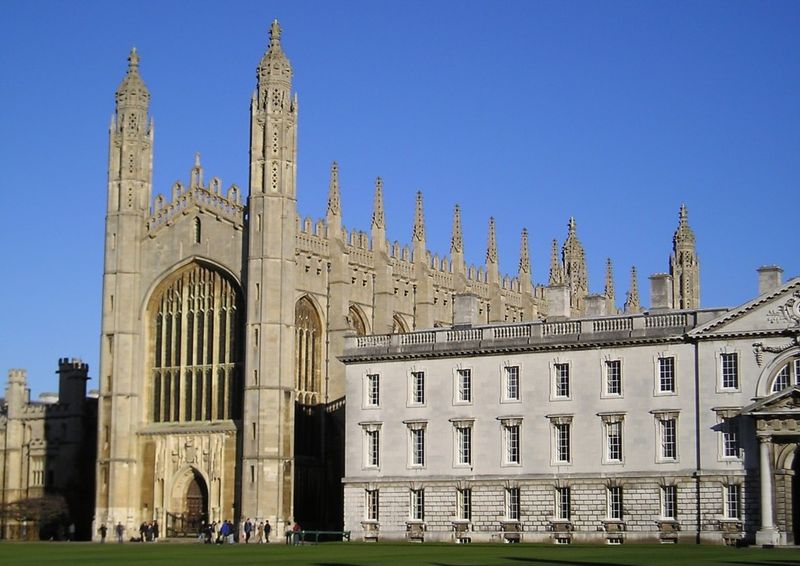
The computer room at King's is now named after Turing, who became a student there in 1931 and a Fellow in 1935.
Turing's hopes and ambitions at school were raised by his strong feelings for his best friend Christopher Morcom, with whom he fell in love, though the feeling was not reciprocated. Morcom died suddenly only a few weeks into their last term at Sherborne, from complications of bovine tuberculosis , contracted after drinking infected cow's milk as a boy. [9]
[ edit ] University and his work on computability
Turing's unwillingness to work as hard on his classical studies as on science and mathematics meant he failed to win a scholarship to Trinity College, Cambridge , and went on to the college of his second choice, King's College, Cambridge . He was an undergraduate there from 1931 to 1934, graduating with a distinguished degree, and in 1935 was elected a fellow at King's on the strength of a dissertation on the Gaussian error function .
In his momentous paper "On Computable Numbers, with an Application to the Entscheidungsproblem " (submitted on 28 May 1936 ), Turing reformulated Kurt Gödel 's 1931 results on the limits of proof and computation, replacing Gödel's universal arithmetic-based formal language with what are now called Turing machines , formal and simple devices. He proved that such a machine would be capable of performing any conceivable mathematical problem if it were representable as an algorithm , even if no actual Turing machine would be likely to have practical applications, being much slower than alternatives.
Turing machines are to this day the central object of study in theory of computation . He went on to prove that there was no solution to the Entscheidungsproblem by first showing that the halting problem for Turing machines is undecidable : it is not possible to decide, in general, algorithmically whether a given Turing machine will ever halt. While his proof was published subsequent to Alonzo Church 's equivalent proof in respect to his lambda calculus , Turing's work is considerably more accessible and intuitive. It was also novel in its notion of a "Universal (Turing) Machine", the idea that such a machine could perform the tasks of any other machine. The paper also introduces the notion of definable numbers .
Most of 1937 and 1938 he spent at Princeton University , studying under Alonzo Church . In 1938 he obtained his Ph.D. from Princeton; his dissertation introduced the notion of relative computing where Turing machines are augmented with so-called oracles , allowing a study of problems that cannot be solved by a Turing machine.
Back in Cambridge in 1939, he attended lectures by Ludwig Wittgenstein about the foundations of mathematics . [10] The two argued and disagreed, with Turing defending formalism and Wittgenstein arguing that mathematics is overvalued and does not discover any absolute truths. [11]
[ edit ] Cryptanalysis
 Two cottages in the stable yard at Bletchley Park. Turing worked here from 1939 – 1940 until he moved to Hut 8.
Two cottages in the stable yard at Bletchley Park. Turing worked here from 1939 – 1940 until he moved to Hut 8.
During the Second World War , Turing was a main participant in the efforts at Bletchley Park to break German ciphers. Building on cryptanalysis work carried out in Poland before the war, he contributed several insights into breaking both the Enigma machine and the Lorenz SZ 40/42 (a teletype cipher attachment codenamed "Tunny" by the British), and was, for a time, head of Hut 8 , the section responsible for reading German naval signals.
Since September 1938, Turing had been working part-time for the Government Code and Cypher School (GCCS), the British codebreaking organisation. He worked on the problem of the German Enigma machine, and collaborated with Dilly Knox , a senior GCCS codebreaker. [12] On 4 September 1939 , the day after Britain declared war on Germany, Turing reported to Bletchley Park, the wartime station of GCCS. [13]
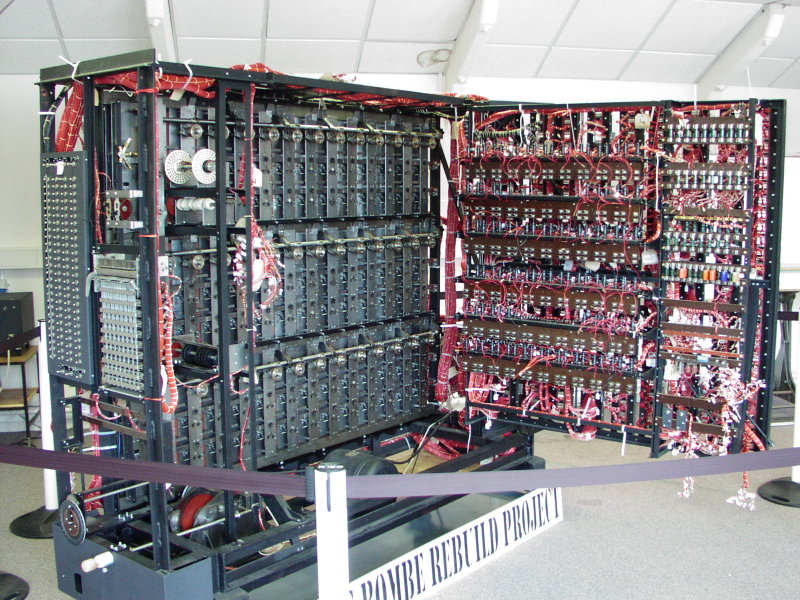
Replica of a bombe machine
[ edit ] The Turing-Welchman bombe
Within weeks of arriving at Bletchley Park, [13] Turing had designed an electromechanical machine which could help break Enigma: the bombe , named after and building upon the original Polish-designed bomba . They were also referred to as “Bronze Goddesses” because their cases were made of bronze, but they were more prosaically described by operators as being “like great big metal bookcases.” [14] The bombe, with an enhancement suggested by mathematician Gordon Welchman , became one of the primary tools, and the major automated one, used to attack Enigma-protected message traffic.
Professor Jack Good, cryptanalyst working at the time with Turing at Bletchley Park, later said: "Turing's most important contribution, I think , was of part of the design of the bombe, the cryptanalytic machine. He had the idea that you could use, in effect, a theorem in logic which sounds to the untrained ear rather absurd; namely that from a contradiction, you can deduce everything." [15]
The bombe searched for possibly correct settings used for an Enigma message (ie, rotor order, rotor settings, etc), and used a suitable " crib ": a fragment of probable plaintext . For each possible setting of the rotors (which had of the order of 10 19 states, or 10 22 for the U-Boat Enigmas which eventually had four rotors, compared to the usual enigma variant's three [16] ), the bombe performed a chain of logical deductions based on the crib, implemented electrically. The bombe detected when a contradiction had occurred, and ruled out that setting, moving onto the next. Most of the possible settings would cause contradictions and be discarded, leaving only a few to be investigated in detail. Turing's bombe was first installed on 18 March 1940 . [17] Over 200 bombes were in operation by the end of the war. [18]
[ edit ] Hut 8 and Naval Enigma
In December 1940, Turing solved the naval Enigma indicator system, which was more complex than the indicator systems used by the other services. Turing also invented a Bayesian statistical technique termed " Banburismus " to assist in breaking Naval Enigma. Banburismus could rule out certain orders of the Enigma rotors, reducing time needed to test settings on the bombes.
In the spring of 1941, Turing proposed marriage to Hut 8 co-worker Joan Clarke, although the engagement was broken off by mutual agreement in the summer.
In July 1942, Turing devised a technique termed Turingismus or Turingery for use against the Lorenz cipher used in the Germans' new Geheimschreiber machine ("secret writer") which was one of those codenamed "Fish". He also introduced the Fish team to Tommy Flowers who under the guidance of Max Newman , went on to build the Colossus computer , the world's first programmable digital electronic computer, which replaced simpler prior machine (inlcuding the "Heath Robinson") and whose superior speed allowed the brute-force decryption techniques to be applied usefully to the daily-changing cyphers. [19] A frequent misconception is that Turing was a key figure in the design of Colossus; this was not the case. [20]
Turing travelled to the United States in November 1942 and worked with US Navy cryptanalysts on Naval Enigma and bombe construction in Washington, and assisted at Bell Labs with the development of secure speech devices. He returned to Bletchley Park in March 1943. During his absence, Hugh Alexander had officially assumed the position of head of Hut 8, although Alexander had been de facto head for some time — Turing having little interest in the day-to-day running of the section. Turing became a general consultant for cryptanalysis at Bletchley Park.
In the latter part of the war, while teaching himself electronics at the same time, and assisted by engineer Donald Bayley , Turing undertook the design of a portable machine codenamed Delilah to allow secure voice communications. It was intended for different applications, lacking capability for use with long-distance radio transmissions, and in any case Delilah was completed too late to be used during the war. Though Turing demonstrated it to officials by encrypting/decrypting a recording of a Winston Churchill speech, Delilah was not adopted for use.
In 1945, Turing was awarded the OBE for his wartime services, but his work remained secret for many years. A biography published by the Royal Society shortly after his death recorded:
"Three remarkable papers written just before the war, on three diverse mathematical subjects, show the quality of the work that might have been produced if he had settled down to work on some big problem at that critical time. For his work at the Foreign Office he was awarded the OBE." [21]
[ edit ] Recollections by Bletchley Park Colleagues
Interviews with his colleagues from his time at Bletchley Park [22] reveal aspects of Turing that are not obvious from the history books. A picture emerges of someone recognized even at the time for his intellect and outstanding contribution but remembered fondly on a personal level, despite his eccentricities.
“I don't think people were an important feature of his life. Ah… I don't know. There must have been some people who mattered a lot to him, certainly. But machines and ideas were his real love, I believe.” – Dr Shaun Wylie, Mathematician
“I rather liked him. Yes.
I felt that he was a character.
He was eccentric in the sense that he, chained his mug, to the um, to the ah radiator so that no one else would take it.” – Professor Jack Good, Cryptanalyst
Turing insisted on taking a hands-on role in building his machines, with sometimes comic results.
“He always soldered with the high tension left on; I can't think why. So, my first memory actually, of coming to the shop is that there was this ra…ther scruffy looking civilian, in a military jacket, bent over the birdsnest, and every now and then he'd go [jumps] ‘OH!' [jumps] ‘OH!' ” – Dr Robin Gandy, Mathematical Logician
[ edit ] Early computers and the Turing Test
From 1945 to 1947 he was at the National Physical Laboratory , where he worked on the design of the ACE (Automatic Computing Engine). He presented a paper on 19 February 1946 , which was the first complete design of a stored-program computer in Britain. Although he succeeded in designing the ACE, there were delays in starting the project and he became disillusioned. In late 1947 he returned to Cambridge for a sabbatical year. While he was at Cambridge, ACE was completed in his absence and executed its first program on 10 May 1950 . In 1948 he was appointed Reader in the Mathematics Department at Manchester and in 1949 became deputy director of the computing laboratory at the University of Manchester , and worked on software for one of the earliest true computers — the Manchester Mark I . During this time he continued to do more abstract work, and in " Computing machinery and intelligence " (Mind, October 1950), Turing addressed the problem of artificial intelligence , and proposed an experiment now known as the Turing test , an attempt to define a standard for a machine to be called "sentient".
In 1948, Turing, working with his former undergraduate colleague, D.G. Champernowne , began writing a chess program for a computer that did not yet exist. In 1952, lacking a computer powerful enough to execute the program, Turing played a game in which he simulated the computer, taking about half an hour per move. The game was recorded; the program lost to Turing's colleague Alick Glennie , although it is said that it won a game against Champernowne's wife.
[ edit ] Pattern formation and mathematical biology
Turing worked from 1952 until his death in 1954 on mathematical biology , specifically morphogenesis . He published one paper on the subject called "The Chemical Basis of Morphogenesis" in 1952, putting forth the Turing hypothesis of pattern formation. [2] His central interest in the field was understanding Fibonacci phyllotaxis , the existence of Fibonacci numbers in plant structures. He used reaction-diffusion equations which are now central to the field of pattern formation . Later papers went unpublished until 1992 when Collected Works of A.M. Turing was published.
[ edit ] Prosecution for homosexual acts and Turing's death
Turing was homosexual [3] in a period when homosexual acts were illegal in Britain and homosexuality was regarded as a mental illness and subject to criminal sanctions. In 1952, Arnold Murray, a 19-year-old recent acquaintance of his, [23] helped an accomplice to break into Turing's house, and Turing went to the police to report the crime. As a result of the police investigation, Turing acknowledged a sexual relationship with Murray, and a crime having been identified and settled, they were charged with gross indecency under Section 11 of the Criminal Law Amendment Act of 1885. Turing was unrepentant and was convicted. He was given the choice between imprisonment and probation, conditional on him undergoing hormonal treatment designed to reduce libido . In order to avoid going to jail, he accepted the oestrogen hormone injections, which lasted for a year, with side effects including gynecomastia (breast enlargement). His conviction led to a removal of his security clearance and prevented him from continuing consultancy for GCHQ on cryptographic matters.
On 8 June 1954 , his cleaner found him dead; the previous day, he had died of cyanide poisoning , apparently from a cyanide-laced apple he left half-eaten beside his bed. The apple itself was never tested for contamination with cyanide, and cyanide poisoning as a cause of death was established by a post-mortem. Most believe that his death was intentional, and the death was ruled a suicide . His mother, however, strenuously argued that the ingestion was accidental due to his careless storage of laboratory chemicals. Biographer Andrew Hodges suggests that Turing may have killed himself in this ambiguous way quite deliberately, to give his mother some plausible deniability. [24] Others suggest that Turing was reenacting a scene from " Snow White ", his favourite fairy tale. [25] Because Turing's homosexuality would have been perceived as a security risk, the possibility of assassination has also been suggested. [26] His remains were cremated at Woking crematorium on 12 June 1954 .
It has been claimed that the Apple Computer logo (an apple with a bite taken out) may be a coded tribute to Alan Turing [27] . Turing's biographer, Andrew Hodges, has asserted that this is false. [28]
[ edit ] Posthumous recognition
Since 1966, the Turing Award has been given annually by the Association for Computing Machinery to a person for technical contributions to the computing community. It is widely considered to be the computing world's equivalent to the Nobel Prize .
Various tributes to Turing have been made in Manchester, the city where he worked towards the end of his life. In 1994 a stretch of the Manchester city inner ring road was named Alan Turing Way.
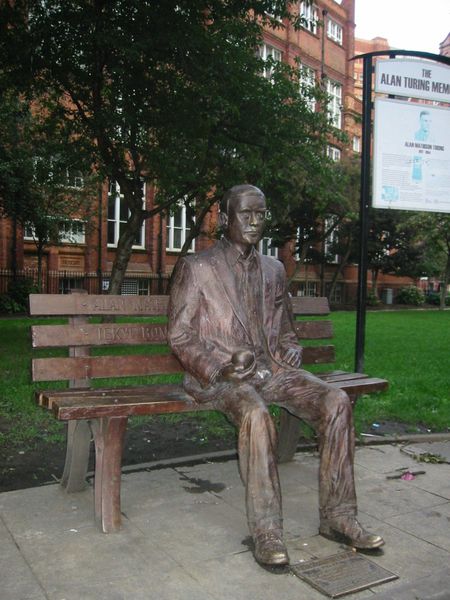
Alan Turing memorial statue in Sackville Park
A statue of Turing was unveiled in Manchester on 23 June 2001 . It is in Sackville Park , between the University of Manchester building on Whitworth Street and the Canal Street ' gay village '. A celebration of Turing's life and achievements arranged by the British Logic Colloquium and the British Society for the History of Mathematics was held on 5 June 2004 at the University of Manchester and the Alan Turing Institute was initiated in the university that summer. The building housing the School of Mathematics , the Photon Sciences Institute, and the Jodrell Bank Centre for Astrophysics is named the Alan Turing Building and was opened in July 2007.
On 23 June 1998 , on what would have been Turing's 86th birthday, Andrew Hodges , his biographer, unveiled an official English Heritage Blue Plaque on his childhood home in Warrington Crescent, London , now the Colonnade hotel. [29] [30] To mark the 50th anniversary of his death, a memorial plaque was unveiled on 7 June 2004 at his former residence, Hollymeade, in Wilmslow.
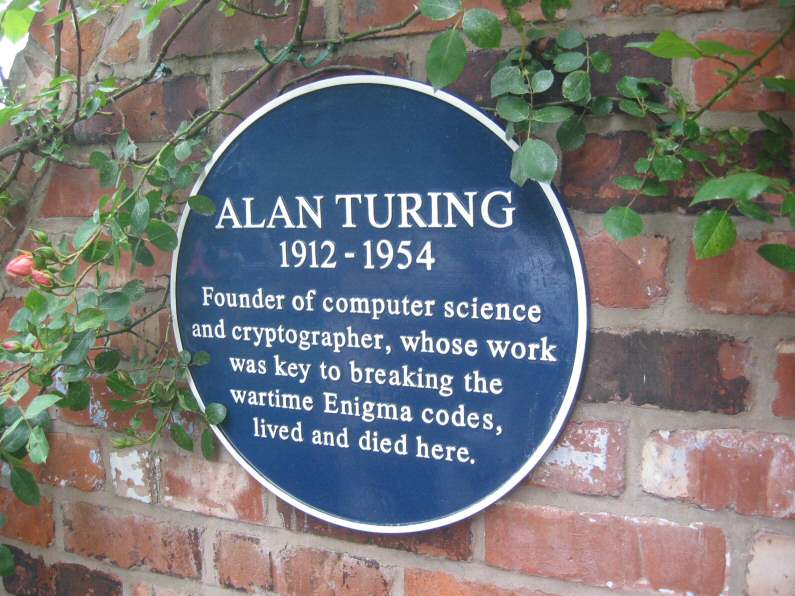
Plaque marking Turing's home
For his achievements in computing, various universities have honoured him. On 28 October 2004 a bronze statue of Alan Turing sculpted by John W Mills was unveiled at the University of Surrey . [31] The statue marks the 50th anniversary of Turing's death. It portrays Turing carrying his books across the campus. The Polytechnic University of Puerto Rico and Los Andes University of Bogotá, Colombia, both have computer laboratories named after Turing. The University of Texas at Austin has an honours computer science program named the Turing Scholars . Istanbul Bilgi University organizes an annual conference on the theory of computation called Turing Days [32] . Cambridge University has a computer lab in King's College, Cambridge named the "Turing Room". Carnegie Mellon University has a granite bench, situated in The Hornbostel Mall, with the name "A. M. Turing" carved across the top, "Read" down the left leg, and "Write" down the other.
Turing is listed on Google Directory as one of the all time top four people in the field of artificial intelligence . [33]
The Boston GLBT pride organization named Turing their 2006 Honorary Grand Marshal. [34]
The Bishop Cotton Boys School 's annual Information Technology competition and festival is known as the Alan Turing Memorial Festival. [ citation needed ]
A 1.5-ton, life-size statue of Turing was unveiled on 19 June 2007 at Bletchley Park. Built from approximately half a million pieces of Welsh slate , it was sculpted by Stephen Kettle , having been commissioned by the late American billionaire Sidney Frank . [35]
The Turing Relay [3] is a six-stage relay race on riverside footpaths from Ely to Cambridge and back to Ely. These paths were used for running by Turing while at Cambridge; his marathon best time was 2 hours, 46 minutes.
[ edit ] Turing in fiction
[ edit ] Further reading
- Agar, Jon (2002). The Government Machine . Cambridge , Massachusetts : The MIT Press . ISBN 0262012022
- Beniger, James (1986). The Control Revolution: Technological and Economic Origins of the Information Society . Cambridge , Massachusetts : Harvard University Press . ISBN 0674169867
- Bodanis, David (2005). Electric Universe: How Electricity Switched on the Modern World . New York: Three Rivers Press. ISBN 0-307-33598-4 .
- Campbell-Kelly, Martin (ed.) (1994). Passages in the Life of a Philosopher . London : William Pickering . ISBN 0813520665
- Campbell-Kelly, Martin, and Aspray, William (1996). Computer: A History of the Information Machine . New York : Basic Books. ISBN 0-465-02989-2
- Ceruzzi, Paul (1998). A History of Modern Computing . Cambridge , Massachusetts , and London : MIT Press . ISBN 0-262-53169-0
- Chandler, Alfred (1977). The Visible Hand: The Managerial Revolution in American Business . Cambridge , Massachusetts : Belknap Press . ISBN 0674940520
- Copeland, B. Jack (2004). "Colossus: Its Origins and Originators". IEEE Annals of the History of Computing 26 (4): 38 — 45.
- Copeland, B. Jack (ed.) (2004). The Essential Turing . Oxford: Oxford University Press. ISBN 0-19-825079-7 .
- Copeland (ed.), B. Jack (2005). Alan Turing's Automatic Computing Engine . Oxford: Oxford University Press. ISBN 0-19-856593-3 .
- Edwards, Paul N (1996). The Closed World . Cambridge , Massachusetts : MIT Press . ISBN 0262550288
- Hodges, Andrew (1983). Alan Turing: The Enigma of Intelligence . London : Burnett Books. ISBN 0045100608
- Leavitt, David (2006) "The Man Who Knew Too Much - Alan Turing and the invention of the computer" Orion Books ltd ISBN 9780753822005
- Lubar, Steven (1993) Infoculture . Boston and New York : Houghton Mifflin . ISBN 039557045
- O'Connor, John J; Edmund F. Robertson " Alan Mathison Turing ". MacTutor History of Mathematics archive .
- Smith, Roger (1997). Fontana History of the Human Sciences . London : Fontana .
- Weizenbaum, Joseph (1976). Computer Power and Human Reason . London : Freeman . ISBN 0716704633
- Williams, Michael R. (1985). A History of Computing Technology . Englewood Cliffs , New Jersey : Prentice-Hall . ISBN 0-8186-7739-2
- Yates, David M. (1997). Turing's Legacy: A history of computing at the National Physical Laboratory 1945 – 1995 . London : London Science Museum . ISBN 0-901805-94-7 .
- Turing's mother, Sara Turing, who survived him by many years, wrote a biography of her son glorifying his life. Published in 1959, it could not cover his war work; scarcely 300 copies were sold. [36] The six-page foreword by Lyn Irvine includes reminiscences and is more frequently quoted.
- Breaking the Code is a 1986 play by Hugh Whitemore , telling the story of Turing's life and death. In the original West End and Broadway runs, Derek Jacobi played Turing – and he recreated the role in a 1996 television film based on the play made jointly by the BBC and WGBH, Boston .The play is published by Amber Lane Press, Oxford . ASIN: B000B7TM0Q
[ edit ] See also
[ edit ] References
- ^ Hodges, 1983, p. 5
- ^ London Blue Plaques . English-Heritage.org.uk . Retrieved on 2007 - 02-10 .
- ^ a b Hodges, Andrew (1983). Alan Turing: The Enigma . New York: Simon & Schuster, pp. 5. ISBN 0-671-49207-1 .
- ^ The Alan Turing Internet Scrapbook . Retrieved on 2006 - 09-26 .
- ^ Jones, G. James ( 2001 - 12-11 ). Alan Turing - Towards a Digital Mind: Part 1 . System Toolbox . Retrieved on 2007 - 07-27 .
- ^ Hofstadter, Douglas R. (1985). Metamagical Themas: Questing for the Essence of Mind and Pattern . Basic Books. ISBN 0465045669 .
- ^ Hodges, 1983, p. 26
- ^ Hodges, 1983, p. 34
- ^ * Teuscher, Christof (ed.) (2004). Alan Turing: Life and Legacy of a Great Thinker . Springer-Verlag . ISBN 3-540-20020-7 .
- ^ Hodges, 1983, p. 152
- ^ Hodges, 1983, pp. 153-154
- ^ Jack Copeland, "Colossus and the Dawning of the Computer Age", p. 352 in Action This Day , 2001
- ^ a b Copeland (ed.), B. Jack (2006). Colossus: The Secrets of Bletchley Park's Codebreaking Computers . New York: Oxford University Press, p. 378. ISBN 019284055X .
- ^ Mary Stewart, 'Bombe' Operator, interviewed in "The Men Who Cracked Enigma", UKTV History Channel documentary series "Heroes of World War II", 2003
- ^ "The Men Who Cracked Enigma", 2003
- ^ Professor Jack Good in "The Men Who Cracked Enigma", 2003: with his caveat: "if my memory is correct"
- ^ Hodges, 1983, p. 191
- ^ Copeland, Jack; Diane Proudfoot (May, 2004). Alan Turing, Codebreaker and Computer Pioneer . Retrieved on 2007 - 07-27 .
- ^ Copeland, 2006, pp. 72
- ^ Copeland, 2006, pp. 382-383
- ^ Newman, M. H. A. (1955). Alan Mathison Turing , Biographical Memoirs of Fellows of the Royal Society, 1955, Volume 1. The Royal Society.
- ^ "The Men Who Cracked Enigma", 2003
- ^ cf. Hodges, pp.449-455
- ^ Hodges, 1983, pp. 488-489
- ^ Ferris, Timothy. Seeing in the Dark . 2002. p. 250
- ^ Leavitt, David (2006). The man who knew too much: Alan Turing and the invention of the computer . New York: W. W. Norton. ISBN 0393052362 .
- ^ "Alan Turing" The Times Online, January 25, 2005 [1]
- ^ Andrew Hodges, "Wondrous Light: 1952-1954" , The Alan Turing Internet Scrapbook, last updated September 2003, last accessed August 2007
- ^ Unveiling the official Blue Plaque on Alan Turing's Birthplace . Retrieved on 2006 - 09-26 .
- ^ About this Plaque - Alan Turing . Retrieved on 2006 - 09-25 .
- ^ The Earl of Wessex unveils statue of Alan Turing . Retrieved on 2007 - 02-10 .
- ^ Turing Days @ Istanbul Bilgi University . Retrieved on 2007 - 02-10 .
- ^ http://www.google.com/Top/Computers/Artificial_Intelligence/People/
- ^ Honorary Grand Marshal . Retrieved on 2007 - 02-10 .
- ^ Bletchley Park Unveils Statue Commemorating Alan Turing , Bletchley Park press release, 20 June 2007]
- ^ Sara Turing to Lyn Newman, 1967, Library of St John's College, Cambridge .
 ี
ี



